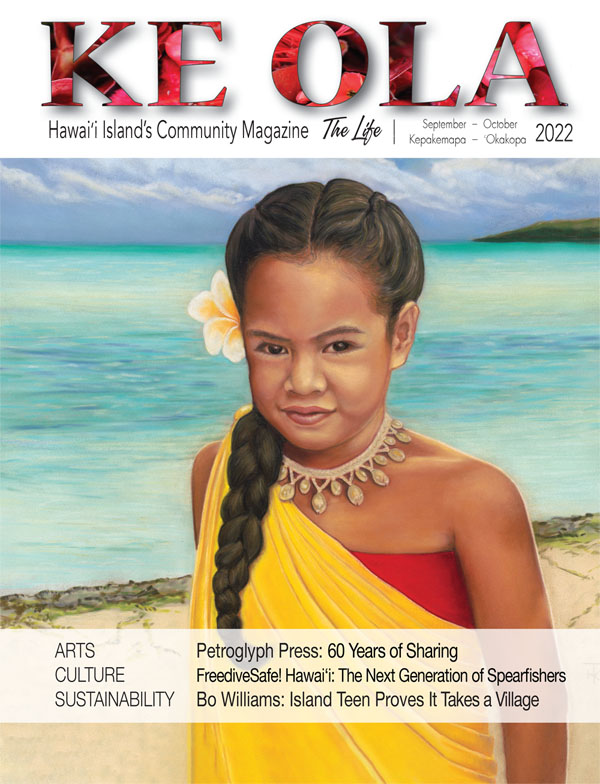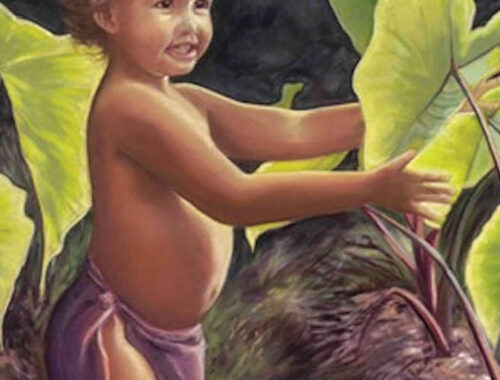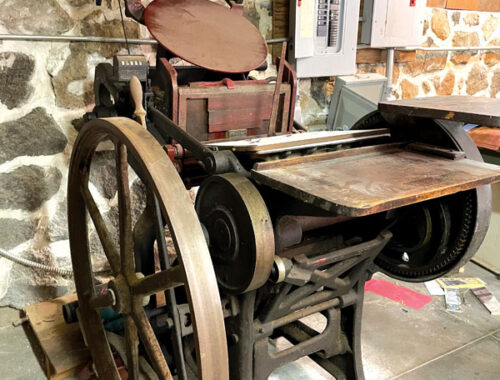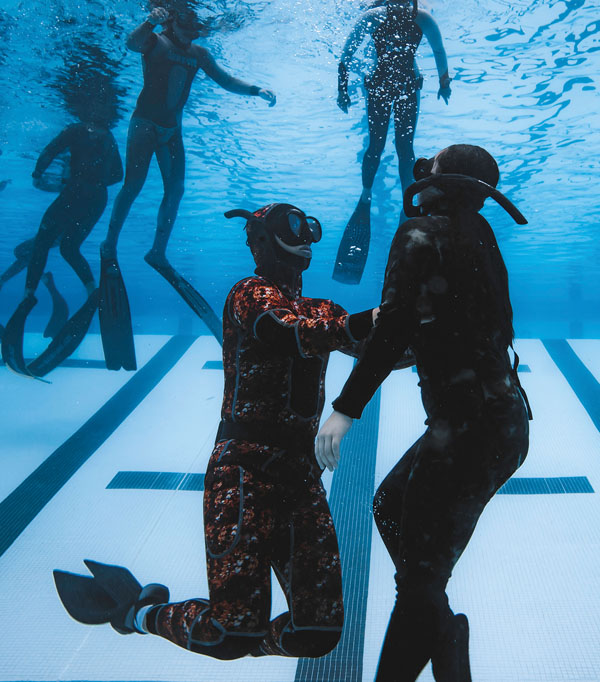
FreediveSafe! Hawai‘i: Lifesaving Training for the Next Generation of Spearfishers
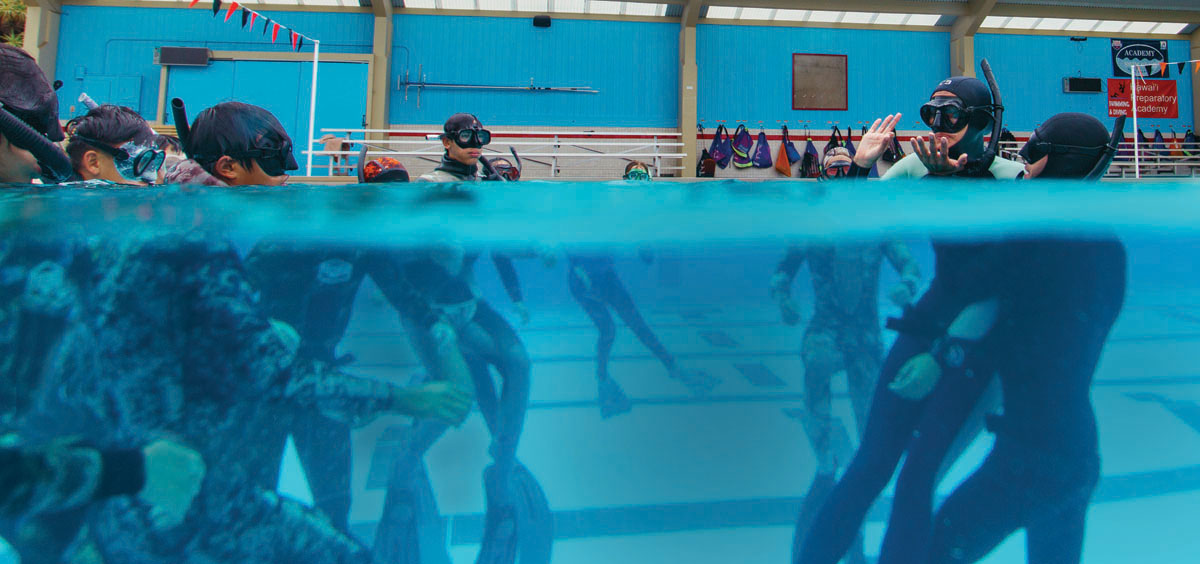
By Sara Stover
On a breezy Saturday morning at the beginning of the summer, 25 of Hawai‘i Island’s youth willingly gather in a classroom at Hawai‘i Preparatory Academy (HPA). Dylan Currier and Sandy Hammel of Freediving Instructors International are demonstrating how to address loss of motor control when freediving.
As Sandy puts her hand under Dylan’s arm and leaves her other hand free, forming a T, she jokes, “Please tell me you wore deodorant today!” which sets off bursts of laughter across the room. Ranging in age from 12 to 25 years old, the young free divers are smiling, learning, and eager to get in the water and apply what the instructors are teaching them about safety, and ultimately, prevention of freediving and spearfishing-related deaths.
For many of these divers, the highlight of the spearfishing safety training event is meeting their hero, Justin Lee, the 2022 USA Spearfishing National Champion. Born and raised on Hawai‘i Island, Justin grew up in Honoka‘a and graduated from HPA.
“Justin is a local boy who has traveled the globe and become the spearfishing world record holder. His success story is an inspiration to Hawai‘i’s young divers,” says Niki Stepanek, founder of FreediveSafe! Hawai‘i, of how Justin volunteers as an instructor, ensuring that these divers come to the training events.
“We live on an island, surrounded by a deep, beautiful ocean filled with yummy creatures that we like to bring home to our ‘ohana. But it can also be dangerous. How many times have we read ‘Spearfisherman Goes Missing’ or ‘Search Continues for Missing Diver’ in the headlines? Too many!” says Justin, who goes on to explain that such tragedies can be prevented by freediving and spearfishing with a partner who has safety training.
As many local families rely on the ocean for subsistence, parents and community members alike find it reassuring to know that FreediveSafe! Hawai‘i is working hard to improve the safety of spearfishing and freediving communities through training across the islands of Hawai‘i.
“My daughter, Kirah, and I had just started freediving when I heard about a diver who went missing,” says Angie, whose 13-year-old is learning about the buddy mentality and ‘one up, one down’ through FreediveSafe! “When I heard about this program, I signed her up right away!”
Combating the Headlines and Reversing the Statistics
“From May to July 2020, we lost five members of the freediving and spearfishing community in Hawai‘i. Two of the divers were freediving on the Big Island,” says FreediveSafe! Hawai‘i’s Niki, a Hawai‘i resident originally from New Zealand, where she remains the National Freediving Record holder. “The blow to our community was insufferable and something had to be done!”
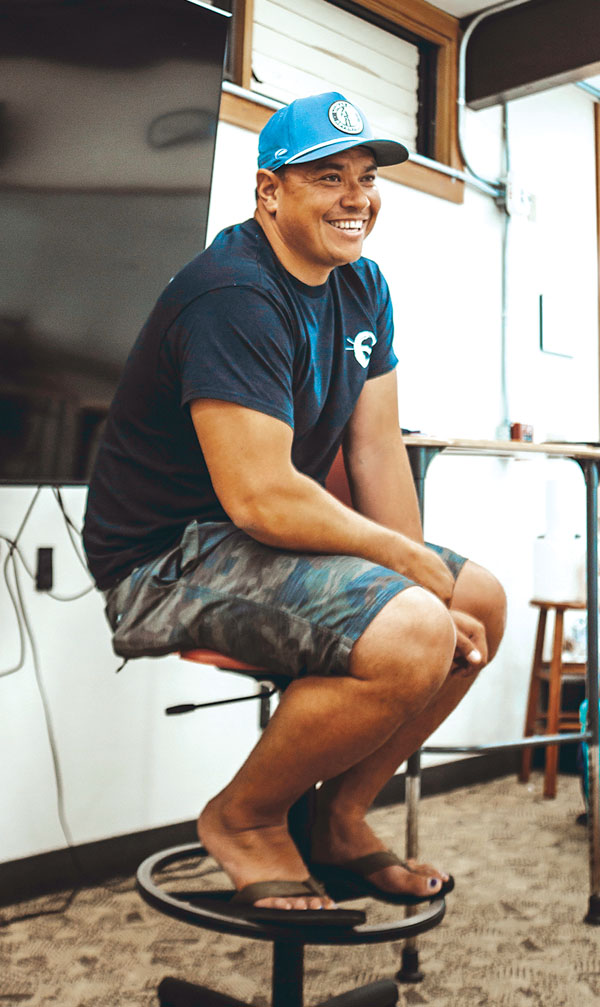
Determined to put a halt to these tragedies, Niki teamed up with freediving and spearfishing professionals, subsistence spearfishermen, and national champion Justin to found FreediveSafe! Hawai‘i in August 2020, and create sustainable, long-term change. By dramatically increasing the availability of lifesaving training, the Kona-based nonprofit is committed to combating the “missing diver” headlines and reversing the current, alarming statistics: according to the State of Hawai‘i Department of Health, 50% of all fatal ocean incidents involving Hawai‘i residents are spearfishing and freediving-related.
As the sport’s popularity continues to grow, so does the need to make safety training more accessible and sport-specific. FreediveSafe! Hawai‘i’s sole goal is to ensure that critical, modern training is available to everyone who needs it.
“Safety training is not about being a strong swimmer. It is very specific to low oxygen events,” Niki points out. “Training divers in protocols proven to mitigate this sport’s risks can be the difference between life and death.”
Prior to 2020, freediving and spearfishing training was only available to those who could afford to spend $300 or more on a class. Currently operating under a local grant, FreediveSafe! Hawai’i is removing any obstacles preventing young free divers from accessing this training by offering free programs across the state.
Justin shares, “Our hope is that these kids who participate in the program will tell their buddy, ‘My life is in your hands if we’re diving together. Before we go, you’ve got to take a class, man!’ and in turn, that kid will tell his other buddies the same thing. Then the next generation of spearfishermen will know the precautions to take, and how to identify and address any sign of danger.”
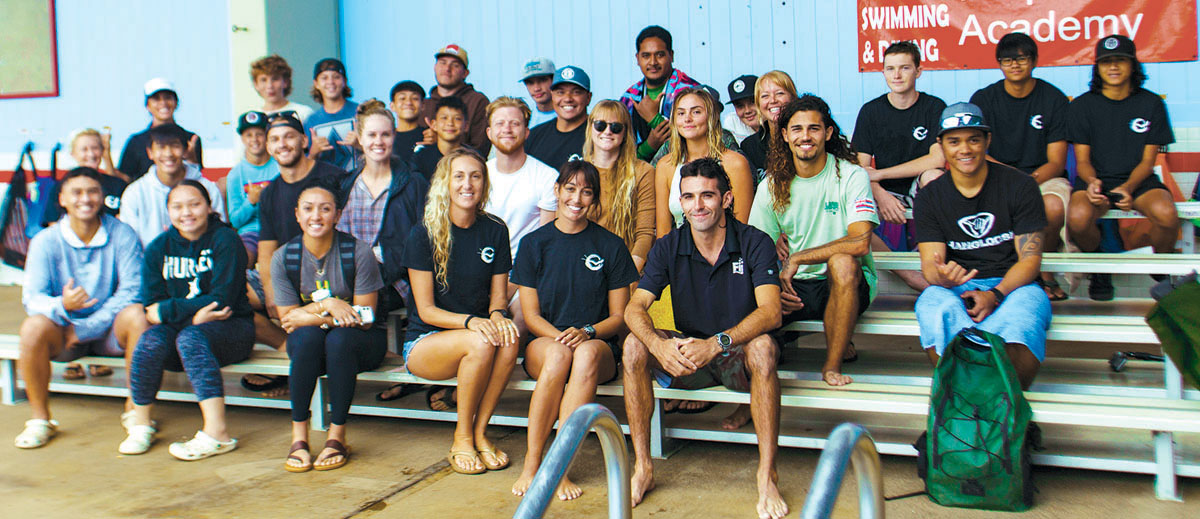
Taking Precautions and Recognizing Symptoms
For Justin Lee, water is life. When he was around 10 years old, he followed his father into the ocean. While he has been spearfishing for the past 28 years, it wasn’t until 2014 that Justin began spearfishing competitively. Just eight short years later, he has won the USA National Spearfishing Championship on Lake Powell with an astounding count of 82 invasive fish.
As one of the top spearfishermen in the world, Justin has formed a special connection with the ocean and shares his experiences beneath the waves on social media, inspiring a massive following. He’s also acutely aware of the risks associated with spearfishing.

“FreediveSafe! is a safety initiative that’s been a long time coming. Spearfishing is a way of life for us in Hawai‘i. I want parents to feel confident knowing their kids are doing it safely,” says the father of two, who is just as passionate about ensuring every diver comes home safe as he is about catching his favorite fish, the mū (bigeye emperor).
“There was this one mū with a scar on his cheek. It took me three months to spear that fish!” Justin exclaims as the young divers crowd around him, soaking up every fishing tale and tip he offers during a FreediveSafe! class break. “You need to be part of the rhythm of the ocean and learn to read the fish. And stay calm. It gets you fish and keeps you safe!”
The students follow Justin back inside, where instructor Dylan teaches them about more precautions and symptoms to be aware of when diving. They learn how to protect their eyes and ears, and that they should never dive when they have a cold. Since freediving is taxing on the nervous system, they review how to rest and hydrate before and after a dive.
Through the program, the young free divers learn what to do when someone experiences a blackout, which commonly happens due to hypoxia (low oxygen). Since the first signs of hypoxia are poor judgment, emotional instability, and disorientation, divers can’t ever be 100% sure that they are within their limits while freediving or spearfishing. This makes having a properly trained partner vital to diving safely and responsibly.
“Bubbles mean trouble. If you see bubbles, protect the airway by putting your buddy in the blackout recovery position,” Dylan asserts as the classroom portion of the program wraps up. “Even if you forget everything you hear today, remember that your number one job is to protect the airway!”
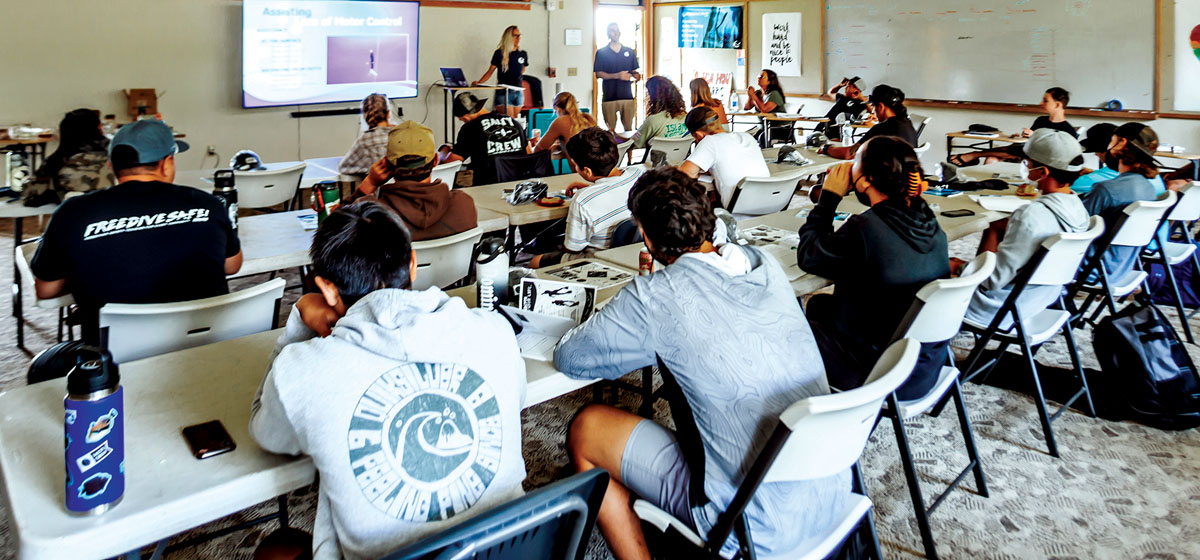
Focusing on the Fish, Staying Safe, and Having Fun
As they head across campus to the pool and suit up, Justin reminds the students how wearing their wetsuit will keep them warm and make them buoyant. Once in the pool, Dylan shows the young divers that they don’t need as much weight as they might assume, while Justin swims around demonstrating how to clear a snorkel.
The pool session is the perfect opportunity to practice what they’ve learned in the classroom, including equalizing the air pressure, so everyone can focus on the fish, stay safe, and have fun.
“The training provided is proven to save lives, allowing everyone to enjoy the freediving and spearfishing lifestyle,” Niki affirms. For young divers like Ka‘ohinani and Dominic Christensen, that means sharing the experience with family and friends. “Dominic got me into this!” says Ka‘ohinani, nodding toward her brother, Dominic. “Now the ocean is my second home. I even caught a tako [octopus]!”
“The best part about diving is being out there with my friends,” Dominic adds. “It’s really good to know the things that could save my friends in the water!”
By the end of the day, the class has amassed a wealth of knowledge and they understand the importance of spearfishing with a partner who has their back. “Take the time to discuss your diving plans with your buddy before each dive. Don’t let anyone make you feel rushed,” Justin reminds them. “Don’t dive with a person who disappears. And bring them to this class!”
The most important lesson the national champion hopes to instill in young divers is to get home safe. “No fish is worth your life!” Justin insists. “Take the preventative measures so we can all get home for dinner tonight, enjoy the fish that we caught together, share it with our ‘ohana, and support our community through fishing.”
From kids who have been freediving since they were old enough to walk to those who just picked up a three-prong last week, the students who participate in FreediveSafe! Hawai‘i are certain to leave with the confidence to stay calm in the water, knowing that they are part of a new generation of spearfishers who can prevent freediving deaths, and make the ocean safer and more enjoyable for everyone. ❖
All photos courtesy of Alyssa Rodrigues
For more information: freedivesafe.org
